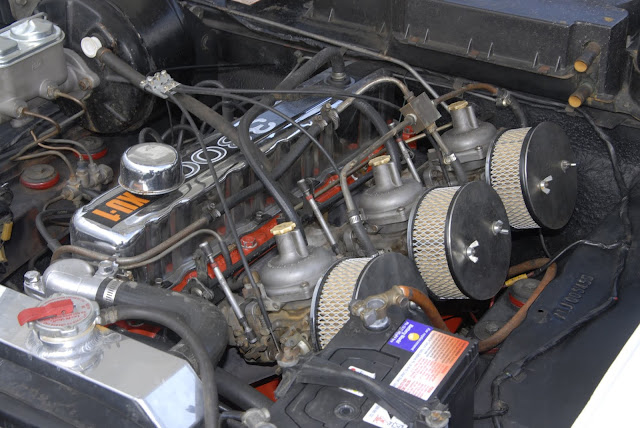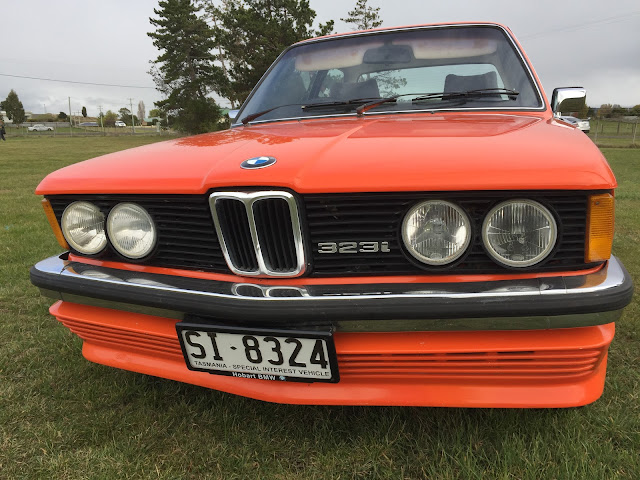Picnic at Ross, 2018
The Post Vintage Car Club of Tasmania's Picnic at Ross, held annually on the third Sunday of May, attracts a genuinely fabulous fleet of classic, performance and exotic cars from all the world's greatest manufacturers. You'll find British, Italian, German, Japanese, American and, of course, Australian marques represented.
The types of vehicle on display are also truly amazing; there's everything from small sedans through to sports cars and GTs, muscle cars, commercials and even campervans. Vehicles range from those manufactured in the 1920s and thirties, right through to the 1990s.
Despite this, there are still cars that surprise even UMPH, who's been a regular at the Picnic for four or five years now. Take, for example, this seemingly innocuous classic Mini.
It's a later edition, featuring what's more or less the original Mini front, but with the tail lights of the Clubman (this is how they were in Britain, when Rover were producing them, right up until the end of the Issigonis-designed Mini range). The duco, panels and chrome are all first-rate. The Minilite wheels look great under the big bolt-on flares, too.
However, closer inspection reveals this particular Mini to be way more exciting than even these features suggest. There's a laurel leaf motif on the sides of the car that reads Mini DOHC VTEC and the centre of the Leyland badge on the boot-lid handle has a very subtle H where there would normally be an L. What's going on ... ?
A peek beneath the bonnet soon shows this Mini is no poseur, having had a very potent 1.6 litre Honda VTEC (https://en.wikipedia.org/wiki/VTEC) shoe-horned into the engine bay, coupled to a five-speed gearbox. It's an incredibly neat job and no mean feat of engineering, either. The radiator has been cleverly remounted and off-set with one corner carefully recessed into the upper-front cross-member. The electricals and plumbing are a a treat to behold, as are all the other modifications that have been made. It's all very Project Binky (https://www.youtube.com/channel/UCHvBHWBzzB7NyU5tIiEZHBg)!
There are twin-pot caliper disc brakes up front and drums on the rear. According to the owner, braking isn't a problem. It's unlikely that handling would be an issue, either, given the Mini's legendary road-holding ability. Interestingly, the VTEC is a popular conversion for another car with prodigious balance and tenacious grip, the Fiat X1/9 (an example of which is also featured in today's article ...).
The dashboard has also been redesigned, featuring a fully digital display. The steering column is adjustable and allows for more rake than normal. The entire interior has been tastefully re-trimmed and has racing-style seats and pedals, and even a decent sound system.
As far as re-engineered Minis go, the one featured here is easily as good as - if not better than - the outrageously-priced but very cool Mini Remastered by David Brown (http://www.davidbrownautomotive.com/mini-remastered/). What do you think? It'd be hard to argue that the VTEC and five-speed gearbox don't give it an edge at least.
Remember the earlier reference to the car being left hand drive? The owner explained that he bought it some years ago, whilst living in Greece, for his wife to drive. They took the car with them when they moved to Canada, where he made the modifications. UMPH is very, very pleased they didn't leave it behind when they relocated to Tasmania!
 |
| Neil Saunders' very tidy 1975 Galant hardtop |
This is Phil's fabulous 1979 "Series 1.5" Fiat X1/9, meaning that, like the UMPH Exxie, it was manufactured with the energy-absorbing bumpers, raised engine cover and interior of the Series II but fitted with the 1.3 litre engine and four-speed gearbox of the Series I. It's commonly believed that this particular configuration was only ever marketed in Australia as a way of using up the remainder of Fiat's Series I running gear.
However, Phil has chosen - as many Australian X1/9 owners do - to replace his 1.3 litre and four-speed gearbox with a 1.5 and the five-speeder from a Series II. Both the engine and 'box were professionally rebuilt by Gorringes in Hobart but Phil did the rest of the work himself.
The standard of Phil's work is very high indeed, with great attention to detail. The duco, panels and interior are all lovely, making for magnificent presentation.
It was also fun to see Phil and his partner unload a full barbecue set-up, complete with chairs and a table, from the car's front and rear storage compartments and set it up, ready for lunch. A few on-lookers seem to have been a bit surprised by the diminutive Fiat's Tardis-like luggage capacity!
For non-Australian readers, this is an LJ Holden Torana XU1, fitted with a 202 cu (3.3 litre) straight-six cylinder engine and a four speed gearbox. It's a classic example of Aussie engineering: General Motors Australia took a vehicle from another market - in this case an insipid Vauxhall from the UK - mucked about with the styling a bit, and bunged an over-sized motor into it.
Doing so may sound crude (it probably is, actually). It was, however, also highly effective, with the comparatively small six-cylinder Holden being able to match the much larger 351 cu (5.8 litre) powered Ford Falcons of the day in motor racing at iconic events such as the famous Bathurst 1000.
If something's worth doing, it's worth overdoing! This is the Torana that fans wanted, Holden considered but was never officially built. It's an "XU2," a 308 cu (5 litre) V8 powered version of the XU1 that some clever bloke has put together. It's been done so well that it looks like a factory edition, right down to the XU2 decals. Given the giant-killing performance of the original XU1, it must be an awesome drive!
GM Australia wasn't the only local manufacturer to implant big engines into small- to medium-sized British cars, as this 250 cu (4.1 litre) six cylinder Ford Cortina shows. Available in the UK with puny 1.3 and 1.6 litre motors, plus an adequate 2 litre version (also available in Australia), Ford Australia thought 3.3 and 4.1 litre sixes would better suit local tastes.
 |
| The protuberance shown above, known in Australia as a Power Bulge, indicates this is a six-cylinder Cortina |
Six-cylinder Cortinas were not as popular as their GM cousins, the Toranas, nor were they often campaigned in motorsports. Very few remain on our roads today but there are a few of the 2 litre versions still about.
Like the Torana, early Holden Commodores were based on a GM sibling - Germany's Opel. In the case of the Aussie Commodore, engine capacities ranged from a pitiful 1.9 litre four cylinder, through to various sixes (2.85, 3.0 & 3.3 litre), and 4.2 and 5.0 litre V8s. There's little doubt this Peter Brock replica would be running the big 5.0!
The Alfa Male no more! This is Scottalie's replacement for the quad-valve 33, lost to an overheating issue a few months back (http://uppermiddlepetrolhead.blogspot.com.au/2018/04/for-sale-alfa-33qv-no-rust-any-offer-be.html).
It's likely the performance of this Fiat 131 will match its hot looks, given it's running the turbo set-up from a Lancia Integrale. Nice. Very nice indeed!
 |
| So striking was this early Falcon ute, it nearly made it as lead photo for this year's Picnic post |
 |
| Family history: this elegant Valiant Regal was bought new by the current owner's uncle and has remarkably low mileage |
As always, thanks go to the PVCC of Tasmania for putting on another excellent event and to the people of Ross for making their town such a welcoming place. Sincere appreciation also to all the car owners for bringing their pride and joys along to what must easily be Tasmania's best car show.
Apologies if your vehicle isn't featured in this article; many of UMPH's favourites, like the silver and orange HQ Monaro that's a regular at the Picnic, sadly had to make way for cars that haven't been featured before. It is, however, very likely that many of them can be seen in previous UMPH Picnic posts (please use the search facility - the magnifying glass icon in the top right of screen - to locate them or any other make or type of vehicle that might interest you).
U M P H
(uppermiddlepetrolhead.blogspot.com.au.)
















































































































Comments
Post a Comment